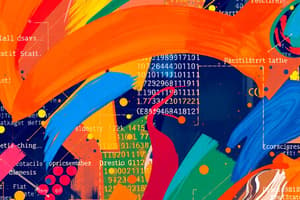Podcast
Questions and Answers
Match the following programming language with its primary use:
Match the following programming language with its primary use:
C = Systems programming language for writing operating systems Python = General-purpose programming language for diverse domains Java = Object-oriented programming language for enterprise applications HTML = Markup language for creating web pages
Match the following C programming language feature with its description:
Match the following C programming language feature with its description:
Syntax = Characterized by simplicity, readability, and efficiency Variables = Utilizes a wide array of data types and supports pointers Functions = Blocks of code that can be reused and called from other parts of the program Pointers = Variables that store memory addresses
Match the following with their role in C programming:
Match the following with their role in C programming:
#include directive = Starts a C program int main() function = Entry point of a C program Data types = Enable versatile control over the types of data used in the program Structures and unions = Custom data types in C
Match the following with their relevance to C programming:
Match the following with their relevance to C programming:
Match the following C programming language features with their descriptions:
Match the following C programming language features with their descriptions:
Match the following C standard libraries with their functions:
Match the following C standard libraries with their functions:
Match the following C programming concepts with their applications:
Match the following C programming concepts with their applications:
Match the following C programming language features with their usage in error handling:
Match the following C programming language features with their usage in error handling:
Match the following C programming language features with their usage in managing program flow:
Match the following C programming language features with their usage in managing program flow:
Match the following C programming language features with their usage in managing memory:
Match the following C programming language features with their usage in managing memory:
Flashcards are hidden until you start studying
Study Notes
Embracing the Power of C: A Comprehensive Guide to C Programming Language
C, a foundational and widely-used programming language, has been an integral part of software development since its inception in 1972. This article delves into the core concepts of C programming, guiding you through its history, syntax, and applications to provide a solid foundation for beginners.
1. Origins and Inception
C was developed by Brian Kernighan and Dennis Ritchie at Bell Labs. It was initially designed as a systems programming language used for writing operating systems, like the UNIX kernel. C has since grown to become a popular choice across diverse domains, such as embedded systems, mobile apps, and high-performance computing.
2. Syntax and Structure
C programming language is characterized by its simplicity, readability, and efficiency. It utilizes a syntax that resembles C++ but is more concise and expressive. A C program starts with the #include <stdio.h> directive, followed by the int main() function. C programs are structured around functions, which are blocks of code that can be reused and called from other parts of the program.
3. Variables and Data Types
C utilizes a wide array of data types, including integers, floating-point numbers, characters, and arrays. C also supports pointers, which are variables that store memory addresses. C offers versatile control over data types, enabling programmers to create custom data types, such as structures and unions.
4. Input and Output
C's standard input and output functions are part of the stdio.h library. These functions enable programmers to interact with the user and display output on the screen. C programs use printf and scanf functions to print to the console and read input from the user, respectively.
5. Control Structures
C employs control structures, such as if-else statements, while loops, and for loops, to manage the flow of a program. These control structures offer programmers the ability to perform conditional operations and iterate over data.
6. Memory Management
C programs need to manage memory dynamically using the malloc and free functions. These functions provide valuable control over memory usage, allowing programmers to allocate and release memory as needed.
7. Functions and Libraries
C offers libraries like stdlib.h and math.h, which contain predefined functions that perform specific tasks. For example, the sqrt function from math.h returns the square root of a number.
8. Error Handling
C's error handling relies on the return value of a function. C programmers utilize the return statement to signal success or failure. The errno variable is also used to store error codes and messages.
9. Compilation and Execution
Compiling a C program involves translating the source code into machine language using a compiler like gcc or clang. This process generates an executable file that can be run on the target platform.
10. Applications and Use Cases
C programming language has extensive applications across various sectors, such as:
- Operating systems (e.g., UNIX, Linux)
- Embedded systems (e.g., microcontrollers)
- Mobile applications (e.g., iOS apps)
- High-performance computing (e.g., scientific simulations)
C's widespread adoption and adaptability have contributed to its long-lasting success.
11. Conclusion
C programming language offers a rich and versatile programming environment. By mastering C and its subtopics, you will possess a powerful set of skills that enable you to excel in a wide range of software development domains. With its simplicity, efficiency, and adaptability, C remains a popular choice for developers worldwide.
Studying That Suits You
Use AI to generate personalized quizzes and flashcards to suit your learning preferences.




